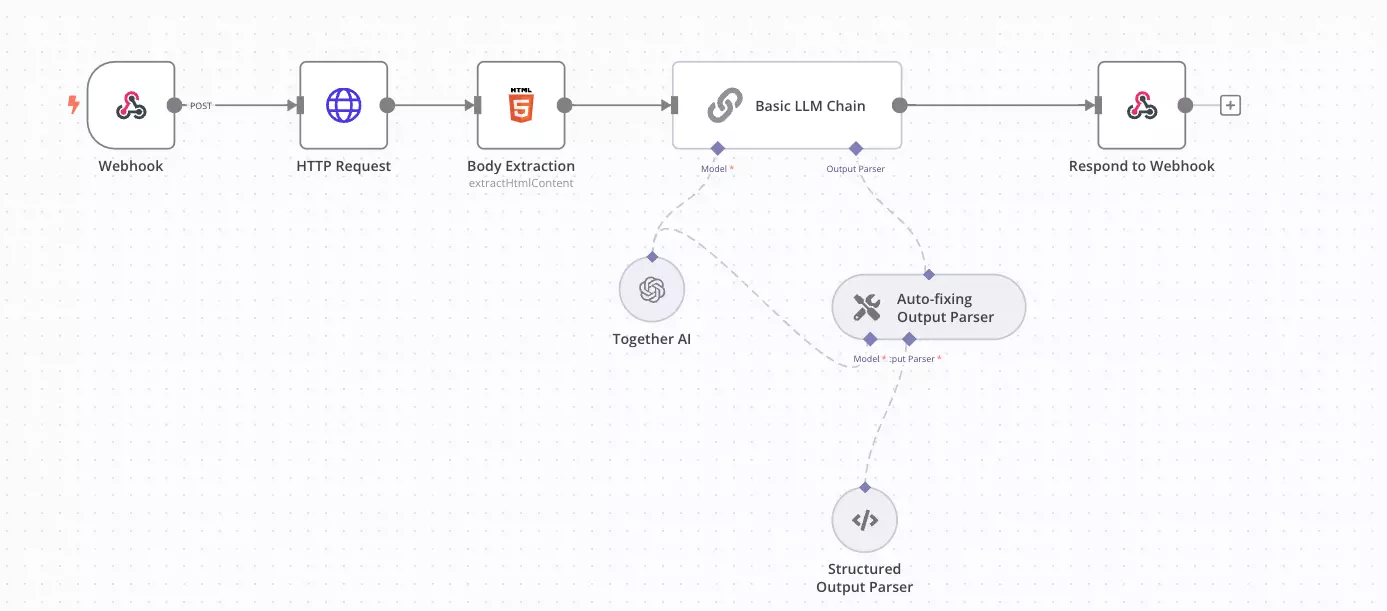
In the ever-evolving landscape of AI and automation, finding tools that simplify complex workflows is invaluable. Enter n8n, a powerful workflow automation tool that integrates seamlessly with AI agents like LangChain. This combination offers a robust platform for experimenting with AI, particularly in extracting structured data from websites and enhancing workflows with notes and subworkflows. In this post, we’ll look into how n8n and LangChain can revolutionize your AI projects, making tasks like recipe extraction from websites both efficient and scalable.
What is n8n?
n8n is an open-source workflow automation tool that enables users to connect various apps and services without writing code. It supports over 400 integrations, making it a versatile choice for automating tasks across different platforms. With n8n, you can create complex workflows that handle data from multiple sources, trigger actions based on specific conditions, and even integrate AI models to enhance functionality.
Key Features of n8n
- Wide Integration Support: n8n supports over 400 apps and services, including popular tools like Google Sheets, Slack, and GitHub, allowing you to automate tasks across your tech stack seamlessly.
- Custom Workflows: Create custom workflows using a visual editor, making it easy to design and manage complex automation processes.
- Open Source: As an open-source tool, n8n offers flexibility and transparency, allowing you to customize and extend its capabilities to suit your specific needs.
Integrating LangChain with n8n
LangChain is a framework for developing applications powered by language models. By integrating LangChain with n8n, you can harness the power of AI to automate tasks such as data extraction, natural language processing, and more. This integration opens up numerous possibilities for experimenting with AI in practical, real-world scenarios.
Setting Up LangChain in n8n
To get started with LangChain in n8n, you need to add the LangChain node to your workflow. This node allows you to connect to various language models and perform tasks like text generation, summarization, and data extraction.
- Add the LangChain Node: In the n8n editor, add the LangChain node to your workflow. Configure the node with your API key and select the desired language model.
- Define the Task: Specify the task you want the AI to perform, such as extracting a recipe from a website. You can use prompts to guide the AI in generating the desired output.
- Process the Output: Use additional n8n nodes to process the AI’s output, such as formatting the extracted data, storing it in a database, or triggering further actions based on the results.
Concrete use case: Extracting Recipes with AI
One practical application of the n8n and LangChain integration is extracting recipes from websites. This task involves using AI to parse web content, identify relevant information, and structure it in a user-friendly format, as seen in the article thumbnail.
Steps to Extract Recipes
- Web Scraping: Use n8n’s HTTP Request node to fetch the HTML content of a recipe webpage.
- AI Processing: Pass the HTML content to the LangChain node, instructing the AI to extract the recipe’s ingredients, instructions, and other relevant details.
- Data Formatting: Use n8n’s data transformation nodes to format the extracted information into a structured format, such as JSON or CSV.
- Storage and Automation: Store the formatted data in a database or trigger further actions, such as sending the recipe to an email or adding it to a document.
Enhancing Workflows with Notes and Subworkflows
Using Notes and Subworkflows
- Adding Notes: Use the Note node in n8n to add comments and explanations to your workflow. This practice is particularly useful for documenting the purpose and functionality of each step, making it easier for others to understand and maintain the workflow.
- Creating Subworkflows: Break down complex workflows into smaller subworkflows that handle specific tasks. This approach not only simplifies the main workflow but also allows you to reuse subworkflows across different projects.
Conclusion
Integrating n8n with LangChain offers a powerful combination for AI experimentation and workflow automation. Whether you’re extracting recipes from websites or automating complex tasks, this integration provides the tools and flexibility needed to streamline your processes. Start exploring the possibilities with n8n and LangChain today, and unlock new levels of efficiency and innovation in your AI projects.

